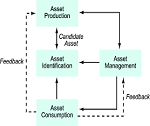
Asset identification and labeling are integral components of effective asset management. They contribute to organizational efficiency, security, compliance, and cost-effectiveness, ensuring that assets are tracked, maintained, and utilized optimally throughout their lifecycle. Asset identification and labeling are fundamental for maintaining an accurate and up-to-date inventory of all organizational assets. This includes hardware devices, software licenses, equipment, and other tangible or intangible items. Asset tagging provides a standardized and systematic way to track assets.Auditors can quickly verify the presence and condition of assets by referencing unique identifiers on asset tags. This ensures accuracy and compliance during internal or external audits.

Data capture and entry in asset tagging are critical for effective asset management, providing the foundation for asset tracking, decision-making, maintenance planning, and overall organizational efficiency. Accurate data contributes to enhanced visibility, security, and compliance, ultimately supporting the organization's strategic objectives. Accurate data capture ensures that each asset is uniquely identified and differentiated from others. This is crucial for preventing confusion, misplacement, or mismanagement of assets, especially when dealing with a large number of items. Capturing relevant data, such as asset descriptions, location, and status, enhances asset tracking and visibility. This information allows organizations to monitor the movement and usage of assets, facilitating efficient tracking throughout their lifecycle.

Cloud-based asset management software offers a range of benefits, including centralized data storage, real-time accessibility, scalability, and cost-effectiveness. These advantages make it a valuable tool for organizations looking to streamline and enhance their asset tagging and management processes. Cloud-based asset management software provides a centralized and secure repository for storing asset-related data. This ensures that all information, including asset tags, descriptions, and status, is easily accessible from a single location, facilitating efficient asset tracking and management. Cloud-based solutions eliminate the need for organizations to invest in and maintain on-premises infrastructure. This reduces upfront costs associated with hardware, servers, and IT infrastructure, making cloud-based asset management software a cost-effective solution.

Asset lifecycle management is integral to the effective management of assets from acquisition to disposal. When combined with asset tagging, ALM provides a comprehensive approach to optimizing asset performance, minimizing costs, and ensuring compliance. Asset lifecycle management facilitates cost optimization by helping organizations make informed decisions about asset investments. By considering the total cost of ownership over the asset's lifecycle. Asset lifecycle management is crucial for organizations seeking to maximize the value of their assets. Asset tagging complements ALM by providing a systematic and efficient way to track, manage, and optimize assets throughout their entire lifecycle. Together, they contribute to improved efficiency, cost-effectiveness, and compliance in asset management processes.

Integration with existing systems is crucial in asset tagging for several reasons, contributing to streamlined processes, improved data accuracy, and enhanced overall efficiency. Integration with existing systems is fundamental for optimizing asset tagging processes. It promotes data consistency, efficiency, and accuracy, contributing to better decision-making, compliance, and overall effectiveness in managing assets throughout their lifecycle. Integration ensures consistency of asset data across various systems. When asset tagging is integrated with existing databases or enterprise resource planning (ERP) systems, it helps eliminate discrepancies and ensures that asset information is uniform across the organization. This reduces the risk of data entry errors and saves time for personnel involved in asset management.

Reporting and analytics play a critical role in asset tagging, providing organizations with valuable insights, supporting informed decision-making, and optimizing overall asset management. Reporting and analytics enable organizations to monitor the performance of tagged assets. Key performance indicators (KPIs) such as utilization rates, maintenance effectiveness, and asset downtime can be tracked and analyzed to assess the overall performance and efficiency of assets. Reporting and analytics aid in tracking and analyzing asset depreciation over time.Analytics support compliance monitoring by providing visibility into whether tagged assets adhere to regulatory standards and organizational policies. This is particularly important in industries where compliance with specific regulations is mandatory.
© 2023 Softeye Solutions Ltd. All Rights Reserved | Design by W3layouts